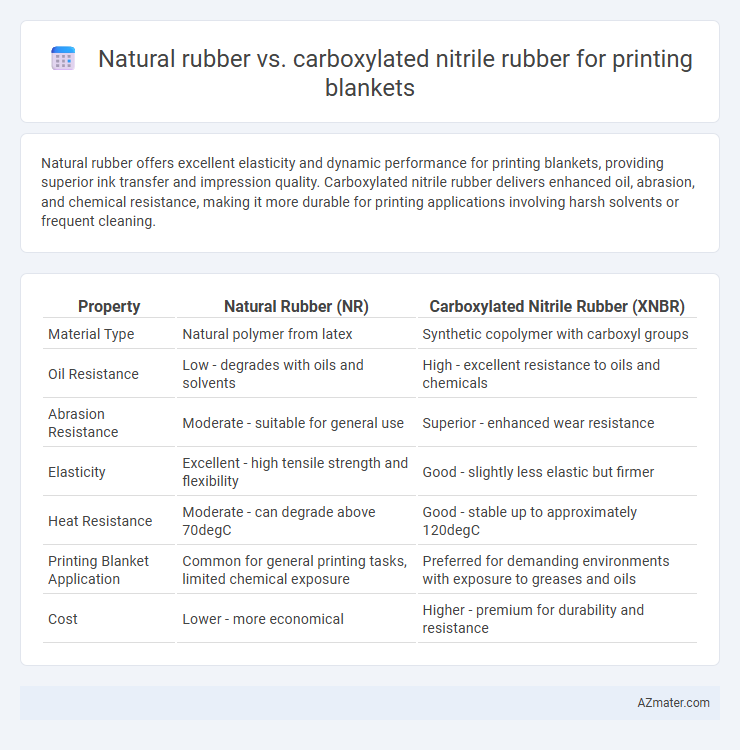Natural rubber offers excellent elasticity and dynamic performance for printing blankets, providing superior ink transfer and impression quality. Carboxylated nitrile rubber delivers enhanced oil, abrasion, and chemical resistance, making it more durable for printing applications involving harsh solvents or frequent cleaning.
Table of Comparison
| Property | Natural Rubber (NR) | Carboxylated Nitrile Rubber (XNBR) |
|---|---|---|
| Material Type | Natural polymer from latex | Synthetic copolymer with carboxyl groups |
| Oil Resistance | Low - degrades with oils and solvents | High - excellent resistance to oils and chemicals |
| Abrasion Resistance | Moderate - suitable for general use | Superior - enhanced wear resistance |
| Elasticity | Excellent - high tensile strength and flexibility | Good - slightly less elastic but firmer |
| Heat Resistance | Moderate - can degrade above 70degC | Good - stable up to approximately 120degC |
| Printing Blanket Application | Common for general printing tasks, limited chemical exposure | Preferred for demanding environments with exposure to greases and oils |
| Cost | Lower - more economical | Higher - premium for durability and resistance |
Introduction to Printing Blankets
Printing blankets require materials with excellent elasticity, abrasion resistance, and ink compatibility to ensure high-quality image transfer on various substrates. Natural rubber offers superior elasticity, resilience, and tackiness, making it ideal for smooth and consistent impressions. Carboxylated nitrile rubber enhances chemical resistance and durability, particularly against oils and solvents, making it suitable for more demanding printing environments where extended blanket life is critical.
Overview of Natural Rubber
Natural rubber offers excellent elasticity, resilience, and tensile strength, making it highly suitable for printing blankets requiring durability and flexibility. Its superior abrasion resistance and high grip allow for precise ink transfer and consistent print quality in various printing applications. Compared to carboxylated nitrile rubber, natural rubber provides better compression set and rebound, essential for maintaining blanket performance under repetitive pressure.
Overview of Carboxylated Nitrile Rubber
Carboxylated nitrile rubber (XNBR) offers superior oil resistance, abrasion durability, and tensile strength compared to natural rubber, making it highly suitable for printing blanket applications. Its enhanced chemical resistance ensures prolonged performance under exposure to printing inks and solvents, reducing downtime and maintenance costs. The presence of carboxyl groups improves adhesion properties, providing better bonding with fabric reinforcements and enhancing overall blanket lifespan.
Key Physical Properties Comparison
Natural rubber exhibits superior elasticity and tensile strength, making it highly resilient for printing blankets requiring flexibility and durability. Carboxylated nitrile rubber, by contrast, offers enhanced oil resistance and improved abrasion resistance, ideal for printing environments exposed to harsh chemicals and mechanical wear. While natural rubber excels in tear resistance and dynamic performance, carboxylated nitrile rubber provides better aging stability and chemical resistance, optimizing printing blanket longevity under industrial stress.
Chemical Resistance: Natural vs Carboxylated Nitrile Rubber
Carboxylated nitrile rubber (XNBR) exhibits superior chemical resistance compared to natural rubber, especially against oils, fuels, and solvents commonly encountered in printing processes. Natural rubber tends to swell and degrade when exposed to these chemicals, reducing the lifespan and performance of printing blankets. XNBR's enhanced cross-linking due to carboxyl groups improves its durability and resistance to chemical attack, making it a preferred choice for printing blanket applications requiring long-term chemical stability.
Performance in Printing Applications
Natural rubber offers excellent elasticity and high tensile strength, making it ideal for printing blankets requiring superior print quality and durability in offset and flexographic printing. Carboxylated nitrile rubber (XNBR) provides enhanced oil, heat, and chemical resistance, ensuring greater longevity and consistent performance in demanding industrial printing environments. While natural rubber excels in flexibility and texture, XNBR outperforms in resistance to ink solvents and mechanical wear, optimizing blanket lifespan and print clarity.
Durability and Longevity
Natural rubber printing blankets exhibit superior elasticity and resilience, enhancing durability by resisting wear and tear during high-speed printing processes. Carboxylated nitrile rubber (XNBR) offers enhanced chemical resistance and aging performance, contributing to extended longevity in harsh printing environments involving oils and solvents. The choice between Natural rubber and XNBR reflects a balance between mechanical toughness and chemical durability, directly impacting printing blanket lifespan.
Cost Considerations
Natural rubber offers a lower initial cost for printing blanket applications due to its abundant availability and simpler processing requirements. Carboxylated nitrile rubber (XNBR) comes with a higher price point, but its enhanced chemical resistance and durability can reduce overall maintenance and replacement expenses over time. Evaluating total cost of ownership reveals that while natural rubber is cost-effective upfront, XNBR may provide better value in high-performance or solvent-exposed printing environments.
Environmental and Safety Aspects
Natural rubber offers superior biodegradability and lower environmental impact due to its renewable origins compared to carboxylated nitrile rubber, which is synthetic and less eco-friendly. Carboxylated nitrile rubber exhibits greater chemical resistance and reduced allergenic potential but relies on petroleum-based raw materials, raising concerns about sustainability and disposal. Both materials require careful handling, yet carboxylated nitrile rubber's resistance to oils and solvents enhances workplace safety by minimizing harmful emissions and contact risks during printing blanket use.
Choosing the Right Rubber for Printing Blankets
Natural rubber offers excellent elasticity, high tensile strength, and superior resistance to abrasion, making it ideal for traditional printing blanket applications requiring flexibility and durability. Carboxylated nitrile rubber (XNBR) provides enhanced chemical resistance, improved oil and heat tolerance, and better aging properties, suitable for printing processes exposed to aggressive solvents and higher operating temperatures. Selecting the right rubber depends on the printing environment, chemical exposure, and performance requirements, with natural rubber preferred for general use and XNBR chosen for demanding industrial conditions.

Infographic: Natural rubber vs Carboxylated nitrile rubber for Printing blanket
 azmater.com
azmater.com